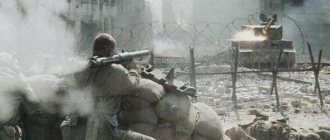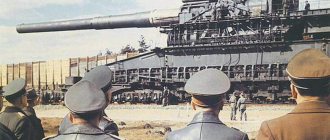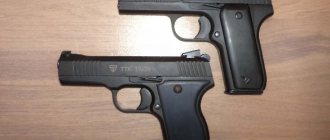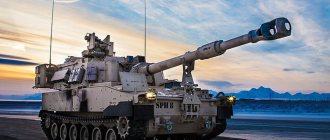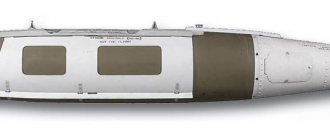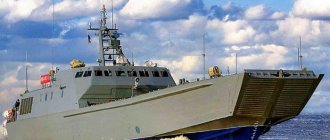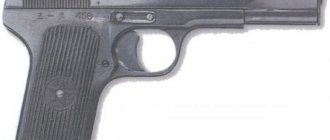Author: Mr.Adamson
02 February 2015 13:49
Tags: future interesting science weapons technology
106189
11
Politician Winston Churchill once said that generals are always preparing for the last war. However, who then is preparing for the war of the future? In the modern century, the military industry does not stand still, but continues to develop technology with the hands of the world's leading design engineers. In today's photo review you will get acquainted with the military technologies of the future, which, according to open sources, are currently being worked on.
0
See all photos in the gallery
XM25 grenade launcher
0
×
The XM 25 semi-automatic self-loading grenade launcher used by the US military is different from the Punisher grenade launcher. The latter was designed to better hit targets located in shelters or in trenches underground. The advantage of the XM 25 grenade launcher is the ability of grenades to explode halfway to the target or near the target. When an explosion occurs in the air, the affected area increases. It has been tested in Afghanistan and will enter service with the US military later this year.
To attack or to defend?
To show this, we need to make a historical interlude and say a few words about the sad fate of the SVT-40 , which before the Great Patriotic War was planned as the main weapon of the army, to replace the Mosin rifle of the 1891/1930 model, but during the war it was inferior to the same "three-line" and submachine guns. There is still no definite opinion about the reasons for this decision; different points of view are expressed. Most often they mention the complexity and high cost of producing the SVT-40 compared to the “three-line” and PPSh .
But still, even if we take into account the difficulties of wartime and the difficult start to production at the evacuated military factories, the disappearance of the SVT-40 seems strange. Nothing prevented the rifle from being modified during the war (especially since almost all types of weapons underwent numerous changes and improvements during the war years), simplifying production, and achieving better accuracy.
Nothing stopped us from turning to the SVT-40 rifle after the war, when the wartime difficulties had been overcome. Finally, if Stalin needed “svetki” in large quantities, then they would have been produced in the required quantities, regardless of any difficulties and hardships. Moreover, the main competitor of the SVT-40, the Shpagin submachine gun, also had many shortcomings. The PPSh is heavy (heavier than the SVT-40) and non-ergonomic, it hangs forward, the neck of the butt is clearly adapted for the wide, calloused worker’s and peasant’s hand, which has just left the plow or hammer. Although it was much simpler and cheaper to produce, nevertheless, during the war years, the quality of production and assembly varied greatly from factory to factory and was often low. The PPSh is praised by those who have never held it in their hands.
But why did the PPSh become a mass weapon? The reason was the tactics of infantry combat. The PPSh had, perhaps, only one major advantage: a high rate of fire and a capacious drum magazine—for 71 rounds. At close range, up to 100 meters, the PPSh fired a powerful and dense burst. At 100 meters, the PPSh in short bursts gave half of the hits into a 30x30 cm square. At 200 meters, the PPSh confidently hit a tall target (or an enemy soldier) with only 3 shots. A good shooter, having used up a magazine, could easily hit 15-20 enemy soldiers. Only a light machine gun could compare with the PPSh in such a role; it was not for nothing that its Finnish analogue “Suomi” often acted as a replacement for a light machine gun.
The advantages of PPSh in close combat led to a change in infantry combat tactics . The instructions recommended getting as close to the enemy as possible, using surprise and the firepower of submachine gunner units. Getting close (or letting them get closer) and striking for sure - this decided the outcome of the battle, especially when it came to storming field fortifications, houses, and city blocks. Tactics, in general, became purely offensive. With the support of artillery or tanks, the infantry approached the enemy to 70-100 meters or less, and then overwhelmed him with massive automatic fire, forced him to retreat, pursued and smashed him.
The SVT-40 did not have such advantages in close combat. On the contrary, the much longer sighting range of fire from this very good rifle made the soldiers prone to passive tactics, firing from a place. Like, let's kill the enemy from afar. A similar argument is now often made in defense of assault rifles. The US Army, in which long-range self-loading and assault rifles have been the main weapons since pre-war times, has always been distinguished by a penchant for such passive tactics, which only strengthened with the massive distribution of collimator and optical sights for the latest modifications of assault rifles. This is clearly visible in numerous videos of battles in Afghanistan.
U.S. Marines typically cluster in positions and fire from cover in hopes of killing the Taliban. However, during the Great Patriotic War, a war known to be maneuverable and assertive, such tactics did not work. The Germans could simply bypass the shooters conducting aimed fire from the spot. Or they brought up heavy machine guns and mortars, and began to rain down the positions of the riflemen with SVT-40 with dense machine-gun fire and fill them with mines. A. Beck’s book “Volokolamsk Highway” describes such a battle. The Germans began to fire at the positions with mortars and soon knocked out about half of the defending company killed and wounded. A little more and the defense would have been crushed. One of the soldiers wounded in a mortar attack said: “To hold on like this means not to hold on.”
Relying on long-range weapons, self-loading or assault rifles, generates passive infantry tactics, leaves the enemy the initiative and leads to defeat and defeat. It is impossible to kill the enemy from afar. This is clearly seen in the example of the US Army, which, even if it won, was only due to its colossal superiority in aviation. In infantry combat, the Americans, due to their tactics, either achieve very modest results or suffer defeat. This spontaneous transition to passive tactics, transferring the initiative to the enemy, did not suit Stalin and prompted him to remove the SVT-40 from production.
Dongfeng-21
0
According to rumors, China has already developed weapons of mass destruction that are capable of hitting American warships at a fairly long distance. One such missile can destroy a super aircraft carrier, as it carries a powerful warhead. In addition to its destructive power, they say that the missile is invisible to radar due to its high maneuverability. And China doesn't stop there.
Railgun
0
The powerful electrode accelerator is theoretically capable of launching rockets into space. The gun was built and tested as an anti-aircraft and anti-submarine weapon. The projectile is launched at a very high speed, close to the speed of sound. This technology is not yet perfect and continues to be improved in the United States. For example, it is planned to equip warships with batteries for charging and reduce the speed of projectile release. They plan to equip ships with such guns by 2025.
DREAD "silent" weapon
0
If a weapon has a name like DREAD, then it can be associated with serious devastating consequences. A weapon of mass destruction, a kind of machine gun, is based on rotating disks, like a centrifuge, from which bullets fly out in a circle. The patent for the invention was received back in 2003. In a minute, the machine gun makes 120,000 revolutions absolutely silently, does not overheat and without recoil. The weapon is currently in the process of being improved, and it is unknown when it will enter service.
New Edge Pistol
A distinctive characteristic is the low-mounted trunk. This ensures high accuracy. And although the solution is not new, many manufacturers strive to lower the barrel axis as much as possible. As a result, the weapon does not leave the aiming line at the moment of shooting, and it is also convenient for the shooter - recoil is less affected due to the fact that it is actually aimed at the palm. In addition, this model is equipped with automatic control, which also reduces recoil.
Designers have not yet been able to abandon some of the physical components that are required to control the weapon. To fire a shot with the New Edge, all you have to do is use your thumb instead of your index finger.
On one side there is a rather large lever, which visually resembles a fuse switch. However, it is designed to control the trigger mechanism.
Aircraft Aurora Excalibur
0
The Aurora Excalibur unmanned aerial vehicle, developed by Aurora Flight Sciences, can take off and land vertically like a helicopter and is also capable of reaching speeds of up to 800 km/h. The vehicle can be equipped with a variety of weapons, including 4 Hellfire anti-tank missiles. The first version of the device was tested successfully in 2009, as a result it was decided to begin full-scale development of a hybrid based on the Apache helicopter. The device will enter service in 5-10 years.
Weapons of the future: what will they use to fight tomorrow?
Throughout its history, humanity has been waging constant wars among itself for territory, resources or any other values. This has always stimulated the invention of new types of weapons for more effective combat and superiority over the enemy. Along with peaceful scientific discoveries and the production of an incredible number of smartphones, tablets and other everyday devices, military technologies are also actively developing. Modified “peaceful” developments are often used. We decided to study this issue from the point of view of gadgets and find out what technologies will be used in military operations in the near future.
TrackingPoint Smart Rifle
Shootings are extremely dangerous. A few years ago, a New Corne automatic rifle was made that can shoot around corners, thereby reducing the likelihood of getting shot. It has its own guidance display. Technologies do not stand still, and now a much more advanced device for such purposes has already appeared. Although it would be more correct to use two devices.
An accurate shot over a long distance is not an easy task. In addition to hand tremors, there are a huge number of factors to consider. TrackingPoint's Intelligent Digital Tracking Scope and Precision Guided Firearm rifle can turn any inexperienced soldier into an accurate shooter. The rifle is equipped with powerful optics, a computer and an automatic trigger mechanism. Using the sight, the shooter places a mark on the desired target, then the computer calculates the trajectory and, at the moment when the shooter points the rifle along the desired trajectory, the automatic trigger fires a shot. Additionally, the rifle has been paired with Google Glass, thanks to which you can make accurate shots without leaning out of cover.
Extreme Accuracy Tasked Ordnance (EXACTO)
Continuing the topic of targeted shooting, one cannot fail to mention a system called Extreme Accuracy Tasked Ordnance (EXACTO), which is being developed by the DARPA agency, which regularly surprises with its innovative developments. The system is designed to enable snipers to accurately hit moving targets that are poorly visible and out of sight, taking into account unforeseen situations (sudden gusts of wind, rain, etc.).
The system consists of a large-caliber rifle (.50 is used in testing), a sight with a target detection and targeting system, and a guided bullet. The EXACTO system allows you to adjust the flight path of an already fired bullet, taking into account current factors and conditions:
Armatix iP1
Many films have already featured various versions of the gun owner identification system: by fingerprint in the James Bond films or by DNA in the film Judge Dredd. Apparently, such options are just around the corner. Armatix iP1, which the creators call the first “smart”, also in some way identifies the owner, although not so high-tech and reliable.
The Armatix iP1 is a .22 caliber pistol with electronic filling, including an electronic magazine release system, a camera interface and (most importantly) an RFID identification system that works in tandem with a special wristwatch. You can pull the trigger only if the gun is no more than 35 cm away from the watch with the RFID chip. The green LED indicates combat readiness. This excludes use in case of theft or if the gun was simply taken away on the street. Such a system cannot be called completely safe: watches can also be stolen. In the meantime, TriggerSmart is developing its own version, with fingerprint identification.
Gauss gun
The Gauss gun (electromagnetic mass accelerator) is mentioned quite often in science fiction computer games and literature. There are a large number of working prototypes, but at the moment their low efficiency does not allow them to be used in practice, especially in real combat operations. Although (in theory) they have a number of useful advantages.
The Gauss gun consists of a solenoid (inductor), with a dielectric barrel placed inside. When current is passed through the solenoid, a magnetic field arises, which accelerates the ferromagnetic projectile and draws it inside the solenoid. Poles are formed at the ends of the projectile, oriented according to the poles of the coil; accordingly, when passing the middle of the coil, the projectile begins to slow down. In order for it to fly further, you need to stop supplying voltage. High projectile speed is achieved thanks to correctly calculated several solenoids, which go one after another and increase the speed of the projectile. The main advantages are the absence of cartridges, strong recoil, high shot volume, higher wear resistance and operation in almost any conditions. Let us remind you that at the moment the efficiency of such devices is extremely low and does not allow serious use. The craftsman assembled a 15-round Gauss cannon with an efficiency of 7%; there are detailed assembly instructions here. Demonstration:
Transforming planes
Regarding flying vehicles, the British defense company BAE Systems came up with a rather bold and interesting idea. Futurologists of this company believe that the future belongs to transformable aircraft, automatic damage repair systems and 3D printers, with the help of which it will be possible to create small drones (more precisely, housings for them) during the operation using pre-prepared equipment.
Transformable aircraft will consist of several smaller modules, each of which has a specific purpose. Depending on the operation, small aircraft with appropriate functionality will be selected, from which the large one will be “assembled”. This approach, according to scientists, will be most effective when flying assembled over long distances and separating the aircraft into component parts during the operation itself.
TALOS
Exoskeletons are a fairly rapidly developing technology that can be used for many applications: from people with limited physical abilities to manufacturing or military purposes. There are a huge number of prototypes, some options have already begun to be mass-produced. These are mainly mechanisms that increase a person’s physical performance, allowing them to lift and carry large loads.
American scientists are developing a similar device for the military called TALOS (Tactical Assault Light Operator Suit), which can bring the capabilities of a soldier closer to Iron Man from the comics. In addition to increasing the soldier’s physical strength, TALOS is equipped with durable armor, a set of sensors that monitor the soldier’s condition, and a helmet with a transparent display on which all the necessary information will be displayed. The project is still far from being actually implemented:
Kuratas
While Boston Dynamics is creating animal- and human-like robots, the Japanese are quietly creating an army of huge controllable Kuratas combat robots. The Japanese love such toys, I wouldn’t be surprised if in the next couple of years they make a functioning prototype of something in the style of the Transformers from the film of the same name. The 4-meter metal monster weighs about 4.5 tons and is driven by a diesel engine and hydraulics.
A lot of weapons can be placed on it; the control system vaguely resembles robots from the movie Avatar. The device completely repeats the movements of a person in the cabin. At this stage of development, it is used exclusively for entertainment purposes at various events.
Leidos ACTUV
Flying military drones is nothing new. They are used by many countries to monitor state borders and for intelligence purposes. DARPA has begun work on creating the Anti-Submarine Warfare (ASW) Continuous Trail Unmanned Vessel (ACTUV), the Leidos company is responsible for the development, and the first copies should appear next year.
The submarine can be used for various purposes, but its main purpose is to detect and track enemy combat submarines. For this purpose, ACTUV is stuffed with a lot of electronics, including radars and sensors, some kind of artificial intelligence, thanks to which submarines will be identified, their movements will be tracked, future actions will be predicted and the appropriate response will be made. ACTUV will be able to autonomously navigate the depths of the ocean for several months.
Adaptive camouflage
The other day we wrote about the technology of adaptive camouflage, which was inherited from cephalopods. Scientists from the University of California also took inspiration from the wild and took advantage of one of the features of squids. Thanks to a complex protein, squids are able to reflect light and change their color. Scientists have managed to synthesize the protein reflectin in the laboratory. It is applied to film and mixed with other chemicals to create an optical filter that makes the object invisible in the infrared.
Infrared equipment is widely used in military applications for night surveillance, navigation and detection of heat-contrasting targets (manpower and equipment). In the future, scientists plan to create a universal coating that will be able to change its color depending on the situation. In nature it looks like this:
Black Knight Transformer
Black Knight Transformer is a fairly sensational and promising development of a universal transport that can move both on land and in the air. The device has a carrying capacity of up to 1.6 tons, can reach speeds of up to 380 km/h and stay in the air for up to 19 hours. The developers plan to make its design modular and use different configurations depending on the case.
An unmanned version for cargo delivery and a floating one with a sealed bottom are planned. The device is currently undergoing various tests.
For those who want to know more
- Jobs of the future: what your dream job will look like in the next decade
- What will the world be like in 2050: 17 predictions of a famous futurologist
- Minecraft Generation: Why Your Kids Will Grow Smarter Than You
- “Goodbye smartphone, goodbye laptop!”: a tour of the most mysterious IT startup Magic Leap
- 20 facts that could not have been predicted 10 years ago
High-energy laser defense system
0
The High Energy Laser Defense System, known as HELLADS, is a weapon that can defeat missiles, artillery and mortars. This is a fairly compact system, convenient for equipping ships. Unlike traditional laser systems, which require a certain period of time to cool down, the HELLADS system is always ready to attack, thanks to the built-in cooling system, which makes this type of weapon effective during military operations. The system has been undergoing testing for 6 years, and it is planned to put it into service in 5 years.
Self-loading "Boa"
The basis for the manufacture of this pistol was well-known solutions and time-tested technology. A powerful 9x21 mm cartridge was used. The product is made according to a classic design and has an interesting appearance. At first it had a utilitarian design in the photo, but was later modified. It has a T-shaped frame, a movable bolt housing and a handle. The material used in this work was polymer.
The weapon has a trigger mechanism that has a double action and the hammer protrudes beyond the former. Fire control is traditional. The Boa Constrictor is equipped with detachable box magazines, which are placed inside the handle shaft. You can lock the magazine using the side button.
The pistol is equipped with a slide stop, which allows you to quickly prepare it for firearms. The delay lever is located on the left side of the frame, above the release hook. The modification, which is compatible with a silencer, has an increased sight height, which allows you to raise the sight line.
Pistols of the future are a great leap forward in the development of weapons, but do not forget about such an indicator as the reliability of the device. The more complex the weapon, the greater the risk of its individual elements breaking. In addition, servicing the product will also not be easy.
Quantum camouflage based on stealth technology
0
A similar phenomenon could be observed in science fiction films. Quantum camouflage based on stealth technology makes a person practically invisible. It was developed in Canada with the support of the United States, both countries are interested in its use during military operations. The principle of operation can be observed while watching the films “The Lord of the Rings” and “Harry Potter”, when light rays emanated from the character, which made him invisible. Such camouflage could save the lives of pilots forced to eject in hostile territory.
Short combat distances
Already during the Second World War, the dispute between a long-range self-loading rifle and a submachine gun was resolved in favor of the latter. This is the main reason to believe that in a likely big war of the future, the dispute between a long-range assault rifle and the same submachine gun will also be decided in favor of the submachine gun. It encourages soldiers, units and troops as a whole to active tactics, approaching the enemy, and an offensive, which is the root of any military victory. Victory does not simply mean destroying the enemy, but means suppressing him, stunning and disorganizing him, destroying his defenses and capturing key positions, putting him to flight and pursuing him without allowing him to come to his senses. How many enemy soldiers were killed is a secondary question.
Then, a review of many wars and armed conflicts very clearly shows that the typical combat distance for small arms does not exceed 100-150 meters . There are many reasons for this.
Firstly , at a greater distance the target (in combat conditions, as a rule, the head or chest) becomes too small, and given the camouflage, inconspicuous, to hit it with confidence. At distances over 200 meters, we are talking about shooting at the body, which, given the proliferation of body armor, becomes very ineffective. But from 50 meters you can confidently hit the head.
Secondly , combat in the forest and in a populated area, when the view is blocked by numerous objects and items, is also limited to the same 100-150 meters or even less.
Thirdly , visibility and, as a result, targeted shooting are limited by smoke, fog, rain, snow, and darkness at night.
Fourthly , combat, with inevitable stress, enemy return fire, frequent dashes, and uncomfortable positions, makes targeted shooting at long distances very difficult. This is not a shooting range where you can lie down comfortably, rest your head and slowly aim your weapon. In battle, only good and cold-blooded shooters can conduct long-range aimed fire. To believe that the entire mobilized army with shaking hands, shortness of breath and barely suppressed fear can hit the enemy’s head 400 meters away would be unjustified optimism.
Since there is a tendency towards an increase in the importance of urban and night combat, in which typical small fire distances are short, it is advisable in arming a mass army to focus on a submachine gun with an aimed combat distance within 100-150 meters. It is better to rely on other types of weapons to defeat the enemy in the distance: machine guns, grenade launchers, mortars, sniper rifles.
Free electron laser system
0
The free electron laser is another development of the US military industry, which is capable of hitting torpedoes, missiles and enemy aircraft. In addition to being able to operate on the principle of rapidly moving electrons in a magnetic field, it will be able to track, identify and target the enemy and transmit information to the command post. Only recently the US Navy awarded a contract to build this system. Previously it was used for non-military purposes. The prototype is expected by 2022.
Hybrid insects
0
A subsidiary of the Defense Advanced Research Project Agency (DARPA), USA, has begun development, which is based on the creation of hybrid beetles, a kind of cyborgs, by implanting them with mechanical devices in the early stages of insect metamorphosis. Thanks to these devices, the beetle can be controlled for military purposes, for example, to reach hard-to-reach targets. These developments require more time and effort to improve in order to become flawless and enter service.
